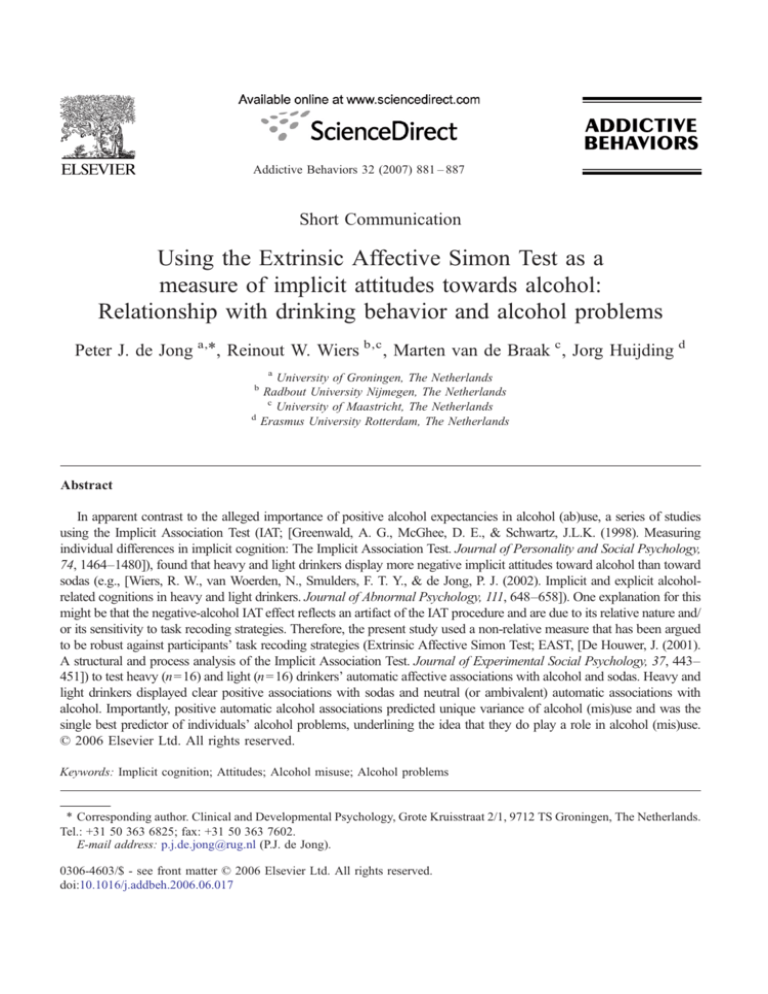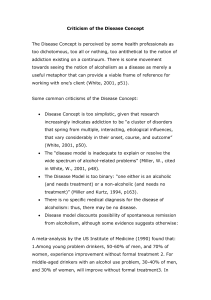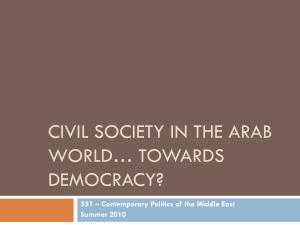
Addictive Behaviors 32 (2007) 881 – 887
Short Communication
Using the Extrinsic Affective Simon Test as a
measure of implicit attitudes towards alcohol:
Relationship with drinking behavior and alcohol problems
Peter J. de Jong a,⁎, Reinout W. Wiers b,c , Marten van de Braak c , Jorg Huijding d
a
b
d
University of Groningen, The Netherlands
Radbout University Nijmegen, The Netherlands
c
University of Maastricht, The Netherlands
Erasmus University Rotterdam, The Netherlands
Abstract
In apparent contrast to the alleged importance of positive alcohol expectancies in alcohol (ab)use, a series of studies
using the Implicit Association Test (IAT; [Greenwald, A. G., McGhee, D. E., & Schwartz, J.L.K. (1998). Measuring
individual differences in implicit cognition: The Implicit Association Test. Journal of Personality and Social Psychology,
74, 1464–1480]), found that heavy and light drinkers display more negative implicit attitudes toward alcohol than toward
sodas (e.g., [Wiers, R. W., van Woerden, N., Smulders, F. T. Y., & de Jong, P. J. (2002). Implicit and explicit alcoholrelated cognitions in heavy and light drinkers. Journal of Abnormal Psychology, 111, 648–658]). One explanation for this
might be that the negative-alcohol IAT effect reflects an artifact of the IAT procedure and are due to its relative nature and/
or its sensitivity to task recoding strategies. Therefore, the present study used a non-relative measure that has been argued
to be robust against participants' task recoding strategies (Extrinsic Affective Simon Test; EAST, [De Houwer, J. (2001).
A structural and process analysis of the Implicit Association Test. Journal of Experimental Social Psychology, 37, 443–
451]) to test heavy (n=16) and light (n=16) drinkers' automatic affective associations with alcohol and sodas. Heavy and
light drinkers displayed clear positive associations with sodas and neutral (or ambivalent) automatic associations with
alcohol. Importantly, positive automatic alcohol associations predicted unique variance of alcohol (mis)use and was the
single best predictor of individuals' alcohol problems, underlining the idea that they do play a role in alcohol (mis)use.
© 2006 Elsevier Ltd. All rights reserved.
Keywords: Implicit cognition; Attitudes; Alcohol misuse; Alcohol problems
⁎ Corresponding author. Clinical and Developmental Psychology, Grote Kruisstraat 2/1, 9712 TS Groningen, The Netherlands.
Tel.: +31 50 363 6825; fax: +31 50 363 7602.
E-mail address: p.j.de.jong@rug.nl (P.J. de Jong).
0306-4603/$ - see front matter © 2006 Elsevier Ltd. All rights reserved.
doi:10.1016/j.addbeh.2006.06.017
882
P.J. de Jong et al. / Addictive Behaviors 32 (2007) 881–887
Insight in people's automatic associations may help explaining the irrational aspects of addictive
behaviors. Automatic associations are assumed to be related to relatively spontaneous responses, whereas
deliberated associations are assumed to be related to more controlled responses (Wilson, Lindsey, &
Schooler, 2000). In the absence of sufficient cognitive resources and/or motivation to control, automatic
associations are also assumed to determine controllable behaviors. Following this, positive automatic
associations may become highly dysfunctional as they may trigger impulsive approach behavior although
the individual knows the stimulus is in fact harmful.
In apparent contrast to the alleged importance of positive expectancies in motivating alcohol abuse,
a series of studies using the Implicit Association Test (IAT; Greenwald, McGhee, & Schwartz, 1998),
found that heavy (and light) drinkers display more negative implicit attitudes toward alcohol than
toward sodas (De Houwer, Crombez, Koster, & De Beul, 2004; Wiers, van Woerden, Smulders, & de
Jong, 2002). Yet, given its relative nature, the alcohol–soda IAT may at least partly reflect positive
associations toward sodas rather than negative associations toward alcohol. Moreover, research
investigating the underlying mechanisms of the IAT provided evidence to suggest that the negative
alcohol IAT effects may reflect non-associative factors (e.g., salience asymmetries) rather than
affective associations (Houben & Wiers, in press). Thus, the earlier findings may well underestimate
the actual importance of positive implicit associations in alcohol misuse. Therefore, this study used the
Extrinsic Affective Simon Test 1 (EAST; De Houwer, 2001), a non-relative measure designed to assess
associations with singular targets and arguably less sensitive to non-associative factors like salience
asymmetries. We separately tested heavy and light drinkers' automatic associations with alcohol and
sodas, and examined the predictive validity of positive automatic associations for (retrospective)
alcohol misuse.
1. Method
1.1. Participants and assessments
Participants were 16 heavy drinking students2 (11 women; alcohol use: M = 30.0 standard servings 3 per
week, S.D. = 18.5; alcohol problems: M = 12.4, S.D. = 6.4) and 16 light drinkers (11 women; alcohol use:
M = 6.5 standard servings per week, S.D. = 4.8; alcohol problems: M = 4.1, S.D. = 4.6). Mean age was
20.3years (S.D. = 1.8). Alcohol use was assessed using the timeline follow-back method (Sobell & Sobell,
1990). Alcohol-related problems were assessed with the 18-item Rutgers Alcohol Problem Index (RAPI;
1
In this study we used the Extrinsic Affective Simon Test as it was originally designed by De Houwer (2001) and was
described in Footnote 4 of his paper. More recently, other versions of the EAST have also been designed using a somewhat
different format.
2
Heavy and light drinkers were selected based on a screening among 192 undergraduate students who indicated to drink at
least one alcoholic consumption per week (n = 163). We selected all available participants scoring in the highest and lowest 10%
of this sample on the basis of average alcohol consumption (as a function of sex) to guarantee sufficient meaningful difference
between the heavy and light drinkers. Mean alcohol use in the eventually selected heavy and light drinkers were comparable to
the alcohol use reported by Wiers et al. (2002) for their samples (heavy drinkers: 30 vs. 32 standard servings; light drinkers: 6.5
vs. 5.1 standard servings).
3
In The Netherlands a standard serving is the equivalent of 10 g alcohol.
P.J. de Jong et al. / Addictive Behaviors 32 (2007) 881–887
883
Table 1
Measuring affective associations with alcohol and soda using the Extrinsic Affective Simon Test
Phase
# Trials
Category, left hand
Category, right hand
1
2
3
4
5
6
7
8
9
40
40
120
40
120
40
120
40
120
Solid
Positive
Solid or positive
Fluid
Fluid or positive
Fluid
Fluid or positive
Solid
Solid or positive
Fluid
Negative
Fluid or negative
Solid
Solid or negative
Solid
Solid or negative
Fluid
Fluid or negative
(C1)
(R1)
(R2)
(C2)
For half of the critical test phases, a particular target category (e.g., solid) shared the response assignment with the positive
attribute category (C1, C2) whereas in the other half of the critical phases the response assignment for a particular target/attribute
combination was reversed (R1, R2). Within each group, response assignments were balanced across individuals (half started with
solid/positive and half of the participants started with solid/negative; for half of the participants within each initial combination,
positive corresponded with left and for half positive corresponded with right). The critical phases are presented in boldface.
White & Labouvie, 1989). The lay-out and experimental procedure of the present Extrinsic Affective
Simon Test (EAST) are very similar to the IAT. For the outline of the task see Table 1.
The attribute categories and exemplars were identical to the IAT used by Wiers et al. (2002). Yet,
the target categories were now the neutral categories ‘solid’ and ‘fluid’ rather than ‘soda’ and ‘alcohol’.
The crucial ‘fluid’ category consisted of the 5 alcoholic and the 5 non-alcoholic drinks used in the
previous studies. The ‘solid’ category consisted of 10 exemplars of food items. Exemplar words were
presented randomly in the middle of a screen (ITI 250ms). Participants sorted the words as fast as
possible to the category names displayed in the left and right corners by pressing the ‘P’ or the ‘Q’.
Phases 1, 2, 4, 6, and 8 were practice stages. During the critical test phases (3, 5, 7, and 9) participants
sorted alternately target and attribute stimuli. For half of the test phases alcohol and soda shared the
response button with positive, and for the other half with negative attributes. The word ‘fault’ appeared
following an incorrect response. To index specific attitudes, we used 100mm Visual Analogue Scales
(VAS) asking for each of the stimuli to what extend they matched with positive (0 = not at all,
100 = very good) or with negative. To assess their global attitudes toward alcohol (and sodas),
participants indicated for each of the positive and negative attributes whether they considered the
drinking of alcoholic drinks (and soda's) to be pleasant, etc., using VASs ranging from 0 (= disagree)
to 100 (=agree).
2. Results
2.1. Specific explicit attitudes
A 2 Drink × 2 Valence × 2 Group ANOVA showed a Drink by Valence interaction [F(1,30) = 59.4,
p < .05], indicating that participants considered soda as more positive than alcohol (see Table 2).
This was similar for both groups [F(1,30) < 1]. Subsequent t-tests indicated that participants' positive
attitudes with alcohol tended to be weaker than the negative attitudes [t(31) = 1.9, p = .06]. With
884
P.J. de Jong et al. / Addictive Behaviors 32 (2007) 881–887
Table 2
Mean (S.D.) positive and negative explicit associations and global attitudes towards alcohol and soda for light and heavy drinkers
Light drinkers
Explicit associations (0–100)
Positive
Negative
Global attitudes (0–100)
Positive
Negative
Heavy drinkers
Alcohol
Soda
Alcohol
Soda
40.2 (15.4)
59.6 (15.0)
72.6 (12.9)
23.1 (13.0)
45.7 (18.8)
51.1 (23.2)
70.0 (12.4)
22.1 (14.0)
52.8 (15.2)
21.6 (14.9)
69.8 (15.5)
7.1 (4.9)
62.1 (18.3)
16.6 (12.5)
61.3 (12.5)
7.2 (9.6)
respect to sodas, positive attitudes were significantly stronger than negative attitudes [t(31) = 11.2,
p < .05].
2.2. Global attitudes
A 2 Drink × 2 Valence × 2 Group ANOVA showed a main effect of Valence [F(1,30) = 309.4, p < .05]
revealing a generally positive attitude toward all drinks (see Table 2). In addition, a Drink by Valence
interaction emerged [F(1,30) = 12.8, p < .05] which was qualified by a Drink by Valence by Group
interaction [F(1,30) = 4.2, p < .05]. Subsequent tests showed that the Drink by Valence interaction was
only significant for the light drinkers [F(1,15) = 16.8, p < .05], but not for the heavy drinkers [F(1,15) =
1.1]. Heavy drinkers showed a similar positive attitude toward sodas and alcoholic drinks, whereas light
drinkers showed a clear preference for sodas.
2.3. Implicit associations
2.3.1. Soda
A 2 Response (positive vs. negative) × 2 Group (heavy vs. light) ANOVA pertaining to participants'
error rates, showed a significant main effect of Response, F(1,30) = 10.4, p < .05, indicating that
individuals were relatively accurate when sodas shared the response button with positive (see Table 3).
None of the other effects reached significance. The pattern of RT-data was consistent with that of the
errors, yet a similar ANOVA revealed no significant effects.
Table 3
Mean reaction times (RT) and error rates (%) for Alcohol and soda trials during the Extrinsic Affective Simon Test (EAST) as a
function of response assignment
Phase
Light drinkers
Heavy drinkers
RT
Error rate
RT
Error rate
EAST–soda
Soda + Positive
Soda + Negative
740 (175)
740 (174)
8.5 (11.7)
11.9 (9.7)
707 (181)
746 (122)
4.3 (5.3)
13.9 (11.7)
EAST–alcohol
Alcohol + Positive
Alcohol + Negative
748 (196)
708 (144)
10.8 (8.2)
10.0 (9.5)
709 (198)
743 (94)
6.0 (5.3)
6.9 (4.6)
P.J. de Jong et al. / Addictive Behaviors 32 (2007) 881–887
885
Table 4
Pearson's correlations between implicit and explicit cognitions and alcohol use and problems
1. EAST-index
2. Explicit Affect
3. Global Attitude (alcohol)
4. Alcohol Problems
5. Alcohol Use (mean)
1
2
3
4
–
.27
.19
.38 ⁎
.37 ⁎
.54 ⁎⁎
.08
.17
.33
.47 ⁎⁎
.78 ⁎⁎
The EAST-index was calculated by subtracting the performance on alcohol trials when alcohol shared the response key with
negative, from the performance on trials of when alcohol shared the response key with positive. Hence high scores indicate
relatively positive alcohol associations. Explicit Affect was calculated as the mean association scores for alcohol exemplars and
positive minus the mean scores of alcohol exemplars and negative. Global Attitude was calculated as the mean of the negative
attributes minus the mean of the positive attributes. Alcohol Problems represent the score on the Rutgers Alcohol Problem Index.
Alcohol Use (mean) reflects the average weekly alcohol consumption.
⁎ p < .05.
⁎⁎ p < .01.
2.3.2. Alcohol
2 Response × 2 Group ANOVAs pertaining to participants' error rates and RTs, revealed no main
effects of Response [F(1,30) < 1], indicative of a neutral or ambivalent implicit attitude towards
alcoholic drinks (see Table 3). The pattern of error rates as well as RTs were similar for both groups
[F(1,30) < 1].
To test whether positive implicit attitudes have independent predictive validity over and above the
explicit measures, we carried out a regression analysis with alcohol problems (RAPI) as the dependent
variable, and EAST-alcohol (RT-index4,5 ), the explicit equivalent of the EAST, and the global attitude
measure as the independent variables. The EAST-index was the only variable with independent predictive
properties [β = .41; p = .02], indicating that relatively positive implicit associations with alcohol are
associated with more negative consequences of alcohol use. A similar analysis with mean alcohol use as
the dependent variable indicated that the global attitude measure best predicted mean retrospective
alcohol use [β = .41, p = .01], whereas the EAST-index showed additional predictive power [β = .30,
p = .06], although the effect did not reach the conventional level of significance. Pearson's p–m
correlations are shown in Table 4.
3. Discussion
The present findings support the idea that the previously reported negative IAT effects may at least
partly reflect positive associations with soda rather than negative associations with alcohol. Both heavy
and light drinkers displayed unambiguously positive implicit associations with sodas, whereas with
4
The EAST-effect was calculated by subtracting the performance on alcohol trials when alcohol shared the response key with
negative, from the performance on trials of when alcohol shared the response key with positive. Hence high scores indicate
relatively positive alcohol associations.
5
To index the reliability of inter-individual variance we computed for both the alcohol–EAST effect and the soda–EAST
effect Cronbach's alphas based on split-half EAST scores. For alcohol α = .48, and for soda RT α = .48.
886
P.J. de Jong et al. / Addictive Behaviors 32 (2007) 881–887
respect to alcoholic drinks the positive and negative automatic affective associations were of similar
strength. This is consistent with the idea that people have an ambivalent rather than a negative implicit
attitude towards alcohol (cf. De Houwer et al., 2004). Such an interpretation is also in agreement with the
results of the explicit measures showing clear positive and clear negative attitudes with alcohol. In support
of the idea that relatively positive automatic associations are involved in alcohol (mis)use, the EAST
showed a positive relation with alcohol-related problems and mean alcohol use. In addition, the EAST
was found to have predictive validity over and above explicit measures with respect to individuals' mean
alcohol use and was the single best predictor of individuals' alcohol problems. Although these findings
are also consistent with the idea that positive associations are a consequence rather than a cause of alcohol
(ab)use, it seems not particularly convincing to argue that the negative consequences of alcohol use might
have resulted in positive implicit alcohol associations.
Some limitations should be acknowledged. First, the EAST contained bipolar attribute categories.
Therefore, the present study cannot differentiate between the possibility that alcohol use is related to
relatively weak negative and/or to relatively strong positive automatic alcohol associations. Second,
although the pattern of EAST-results was in line with the idea that heavy drinkers are characterized
by relatively positive automatic alcohol associations, the difference between light and heavy drinkers
did not reach significance. One explanation might be that since our heavy drinkers consisted of
undergraduates rather than treatment seeking people, the level of alcohol problems may not have been
sufficiently extreme and homogeneous to reliably differentiate between groups in a factorial analysis.
Consistent with this, the correlational analyses did reach significance (see also Wiers et al., 2002). To
conclude, the present pattern of results strongly suggests that the negative implicit alcohol
associations that were found in previous studies were due to the specific characteristics of the
alcohol–soda IAT. The finding that the EAST predicted unique variance concerning the indices of
alcohol misuse not only sustains the alleged importance of relatively positive evaluative alcohol
associations in drinking behavior, but also underlines the importance of implicit assessments of
alcohol-related cognitions.
Acknowledgement
The authors are grateful to Annie Raven for her assistance during data acquisition, Bert Hoekzema for
his technical assistance, and Jan De Houwer for his comments on an earlier version of the manuscript.
References
De Houwer, J. (2001). A structural and process analysis of the Implicit Association Test. Journal of Experimental Social
Psychology, 37, 443−451.
De Houwer, J., Crombez, G., Koster, E. H. W., & De Beul, N. (2004). Implicit alcohol-related cognitions in clinical samples of
heavy drinkers. Journal of Behavior Therapy and Experimental Psychiatry, 35, 275−286.
Greenwald, A. G., McGhee, D. E., & Schwartz, J. L. K. (1998). Measuring individual differences in implicit cognition: The
Implicit Association Test. Journal of Personality and Social Psychology, 74, 1464−1480.
Houben, K., & Wiers, R. W. (in press). A test of the salience asymmetry interpretation of the Alcohol–IAT. Experimental
Psychology.
Sobell, L. C., & Sobell, M. B. (1990). Self-report issues in alcohol abuse: State of the art and future directions. Behavioral
Assessment, 12, 77−90.
P.J. de Jong et al. / Addictive Behaviors 32 (2007) 881–887
887
White, H. R., & Labouvie, E. W. (1989). Towards the assessment of adolescent problem drinking. Journal of Studies on Alcohol,
50, 30−37.
Wiers, R. W., van Woerden, N., Smulders, F. T. Y., & de Jong, P. J. (2002). Implicit and explicit alcohol-related cognitions in
heavy and light drinkers. Journal of Abnormal Psychology, 111, 648−658.
Wilson, T. D., Lindsey, S., & Schooler, T. Y. (2000). A model of dual attitudes. Psychological Review, 107, 101−126.







